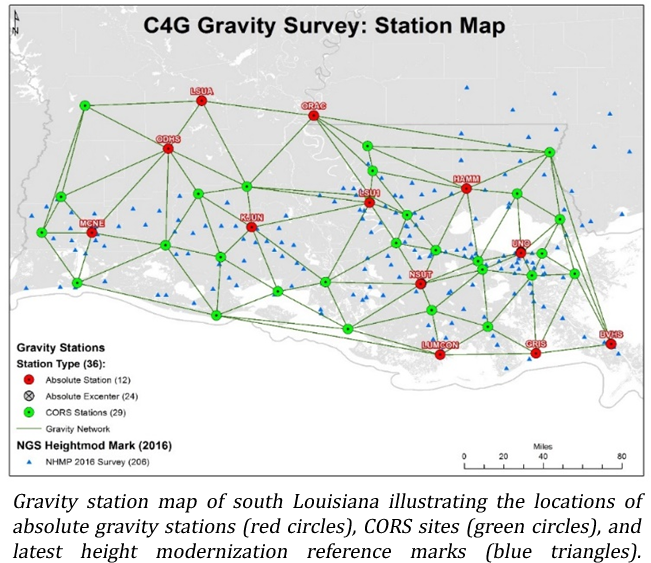 The Center for GeoInformatics (C4G) in the Department of Civil and Environmental Engineering (CEE) recently received new geodetic instruments to model the Earth’s gravity field. A Scintrex CG-5 Relative Gravity Meter, Leica T60 Total Station, and Trimble R10 GPS Rover Kit were acquired as part of an enhancement grant sponsored by the Louisiana Board of Regents. Drs. George Voyiadjis (PI) and Joshua Kent (Co-PI) led the one-year project, which ended in June, 2017. The instruments are acquired to address the needs of three objectives: First, to develop a novel, high-resolution gravity model of sea level (i.e., geoid); second, to augment knowledge of existing subsidence rates and the driving mechanisms; and finally, promote advanced geodetic research at the University.
The Center for GeoInformatics (C4G) in the Department of Civil and Environmental Engineering (CEE) recently received new geodetic instruments to model the Earth’s gravity field. A Scintrex CG-5 Relative Gravity Meter, Leica T60 Total Station, and Trimble R10 GPS Rover Kit were acquired as part of an enhancement grant sponsored by the Louisiana Board of Regents. Drs. George Voyiadjis (PI) and Joshua Kent (Co-PI) led the one-year project, which ended in June, 2017. The instruments are acquired to address the needs of three objectives: First, to develop a novel, high-resolution gravity model of sea level (i.e., geoid); second, to augment knowledge of existing subsidence rates and the driving mechanisms; and finally, promote advanced geodetic research at the University.
Here, as in many river deltas around the world, land surfaces are sinking due to subsidence. On average, southern Louisiana experiences ~10 millimeters per year of subsidence. Understanding the mechanisms that drive subsidence is essential for mitigating risk and promoting sustainability. The CG-5 relative gravity meter supports these goals by measuring the relative differences in the Earth’s gravity across southern Louisiana.  Surveys using the total station and R10 rover kit are currently underway to geodetically correlate the CG-5 data with absolute gravity readings collected in the early 2000s by the National Geospatial-Intelligence Agency and the National Geodetic Survey. The updated gravimetric surveys conducted by C4G researchers and staff will deliver much needed insight into the variety of geophysical processes driving the spatially and temporally heterogeneous rates of subsidence measured across the state.
Surveys using the total station and R10 rover kit are currently underway to geodetically correlate the CG-5 data with absolute gravity readings collected in the early 2000s by the National Geospatial-Intelligence Agency and the National Geodetic Survey. The updated gravimetric surveys conducted by C4G researchers and staff will deliver much needed insight into the variety of geophysical processes driving the spatially and temporally heterogeneous rates of subsidence measured across the state.
In addition to the subsidence research, this enhancement grant will directly and indirectly benefit Louisiana’s geodetic stakeholder and consumer communities. For nearly a decade, the C4G has provided tools, services, and other geodetic resources dedicated to precise positioning throughout the state and across the region.  Central to these resources is the C4GNet real-time reference network. The network includes more than 50 continuously operating GPS reference stations (CORS) installed across Louisiana.
Central to these resources is the C4GNet real-time reference network. The network includes more than 50 continuously operating GPS reference stations (CORS) installed across Louisiana. Over the next five years, the C4G plans to geodetically correlate the gravity measurements with antenna heights at each station. Extended surveys will include CORS in neighboring states. When completed, the data will contribute to the creation of a novel, high-resolution geoid model that will allow the geodetic community to accurately and precisely measure elevations above sea level.
Over the next five years, the C4G plans to geodetically correlate the gravity measurements with antenna heights at each station. Extended surveys will include CORS in neighboring states. When completed, the data will contribute to the creation of a novel, high-resolution geoid model that will allow the geodetic community to accurately and precisely measure elevations above sea level.
The instruments acquired by this grant represent an investment into the geodetic research capacity at the C4G and CEE. In addition to the above goals and objectives, these resources have already been selected for use by investigators in two external funding proposals, both of which will rely on the precision of these instruments to deliver meaningful geodetic solutions. These instruments not only promote research activities, they have galvanized national and international collaborations with partners across the US Gulf Coast and western Europe. More information about these instruments and geodetic models is available at the C4G website www.c4g.lsu.edu or gravity.c4g.lsu.edu.
